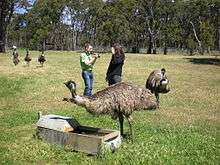Cleland Conservation Park
| Cleland Conservation Park South Australia | |
|---|---|
|
IUCN category II (national park) | |
|
Entrance to the park | |
 Cleland Conservation Park | |
| Nearest town or city | Adelaide city centre |
| Coordinates | 34°58′03″S 138°41′45″E / 34.96750°S 138.69583°ECoordinates: 34°58′03″S 138°41′45″E / 34.96750°S 138.69583°E |
| Established | 1 January 1945[1] |
| Area | 11.25 km2 (4.3 sq mi)[1] |
| Managing authorities | Department of Environment, Water and Natural Resources |
| Website | Cleland Conservation Park |
| See also | Protected areas of South Australia |

Cleland Conservation Park is a protected area located in the Adelaide Hills, South Australia about 22 kilometres (14 mi) south-east of the Adelaide city centre.[2] Cleland Conservation Park conserves a significant area of natural bushland on the Adelaide Hills face and includes the internationally popular Cleland Wildlife Park and the popular tourist destinations of Mount Lofty summit and Waterfall Gully.[2] It is maintained by the South Australian Department of Environment, Water and Natural Resources (DEWNR).[2]
The conservation park was named for Sir John Burton Cleland (1878-1971), a renowned naturalist, microbiologist, mycologist and ornithologist, and member of the Royal Society of South Australia. After a career in medicine and pathology, Cleland became keenly interested in wildlife conservation.[3]
The conservation park is classified as an IUCN Category II protected area.[4]
Cleland Wildlife Park

The Wildlife Park is accessible by sealed road from both the South Eastern Freeway and Greenhill Road, and on foot on a formed but steep track from Waterfall Gully or Mount Lofty.[5] A limited public bus service operates (Route 823: 3 journeys each day).[6] A fee is payable to enter the Wildlife Park (but not to the Conservation Park except for car parking at Mt Lofty summit).
Cleland Wildlife Park offers visitors an opportunity to walk through large enclosures and interact with Australian animals such as kangaroos, koalas and emus, and to see others including wombats, dingos and many bird and reptile species. The park also has a variety of rare and endangered species such as the yellow-footed rock-wallaby, bush stone-curlew and brush-tailed bettong.
Facilities include a souvenir shop, cafe and toilets. Many visitors pay to be photographed holding koalas.[7] Several other options are available to visitors, including an Aboriginal guide on a Cultural Tour of the Yurridla Aboriginal Trail, which explains dreaming stories of dingoes, emus, koalas and Yurrabilla, the creation ancestor, and a nightwalk, uncovering the secrets of the bush.
Mount Lofty summit
This popular tourist destination is 727 metres (2,385 ft) above sea level. It provides sweeping vistas across the Adelaide Plains and Gulf St Vincent. Flinders Column, a white painted obelisk shaped like a lighthouse, is a landmark which can be seen from far away on a clear day.
Car parking facilities are provided: charges are payable. Public bus route 823 serves the summit with three journeys a day (including weekends and most holidays).[6]
Other facilities include an information centre/ souvenir shop, a cafe/restaurant (closed Mondays) and public toilets.
Waterfall Gully

Waterfall Gully, another popular part of the park, is located on its western edge. It can be accessed via the sealed Waterfall Gully Road. A limited amount of free car parking is provided. There is no scheduled public transport service.
The main attraction is a waterfall, the largest of several in the park. The base is a short walk from the car park and the top can be reached by a formed but steep footpath, which continues to Cleland Wildlife Park and Mount Lofty summit.[8]
Other facilities include a kiosk/ restaurant and public toilets.
Other
By far the largest part of the park consists of bushland, mostly woodland with some open spaces where clearing has taken place.[9]
There are a number of walking trails, including the Waterfall Gully - Mount Lofty summit trail which is a popular and reasonably challenging ascent of the west side of Mount Lofty,[5] and parts of the long distance Heysen and Yurrebilla Trails, which run north–south along the higher ground in the east of the park.
As of 22 December 2012, many trails in the park became shared-use, allowing mountain bikers to also make use of the trails.[10]
See also
References
- 1 2 "Protected Areas Information System - reserve list (as of 16 July 2015)" (PDF). Department of Environment Water and Natural Resources (DEWNR). Retrieved 3 August 2015.
- 1 2 3 "Cleland Conservation Park". Department of Environment, Water and Natural Resources. Retrieved 18 November 2015.
- ↑ R. V. Southcott, 'Cleland, Sir John Burton (1878–1971)', Australian Dictionary of Biography, National Centre of Biography, Australian National University, , published in hardcopy 1981, accessed online 18 April 2014.
- ↑ "Terrestrial Protected Areas of South Australia (see 'DETAIL' tab)". CAPAD 2012. Australian Government - Department of the Environment. 2014. Retrieved 13 March 2015.
- 1 2 http://www.southaustraliantrails.com/trails.asp?id=13811 Retrieved 15-05-2009
- 1 2 http://www.adelaidemetro.com.au/ttsearch.php?action=search&searchtext=823 Retrieved 15-05-2009
- ↑ "Example photo of visitor holding a koala". Photobucket.
- ↑ http://www.southaustraliantrails.com/trails.asp?id=13811
- ↑ A Hardy The Nature of Cleland 2nd Ed 1989
- ↑ http://www.ridemorebikes.com/mountain-biking-cleland-conservation-park/ Retrieved 02-01-2013
Further information
- A Hardy. The Nature of Cleland 2nd Ed. 1989
External links
![]() Media related to Cleland Wildlife Park at Wikimedia Commons
Media related to Cleland Wildlife Park at Wikimedia Commons
| ||||||||||

